Semantic features of English collocations with the verb ''make'' in international criminal documents: Difficulties with, and suggestions for learning and translating
One of the most problematic areas for foreign language learning is collocation. It
is often seen as a seemingly insurmountable obstacle to the attainment of native
like fluency. The following study takes an approach as a linguistic one by
analyzing semantic features of the English collocations with „make‟, which is
widely used in the international criminal documents. The thesis analyzing their
semantic features according to the categorization of the English collocations with
„make‟ used in the international criminal documents in order to find out the
difficulties for learners and translators in dealing with these collocations as well
as to impose the suggestions for these difficulties.
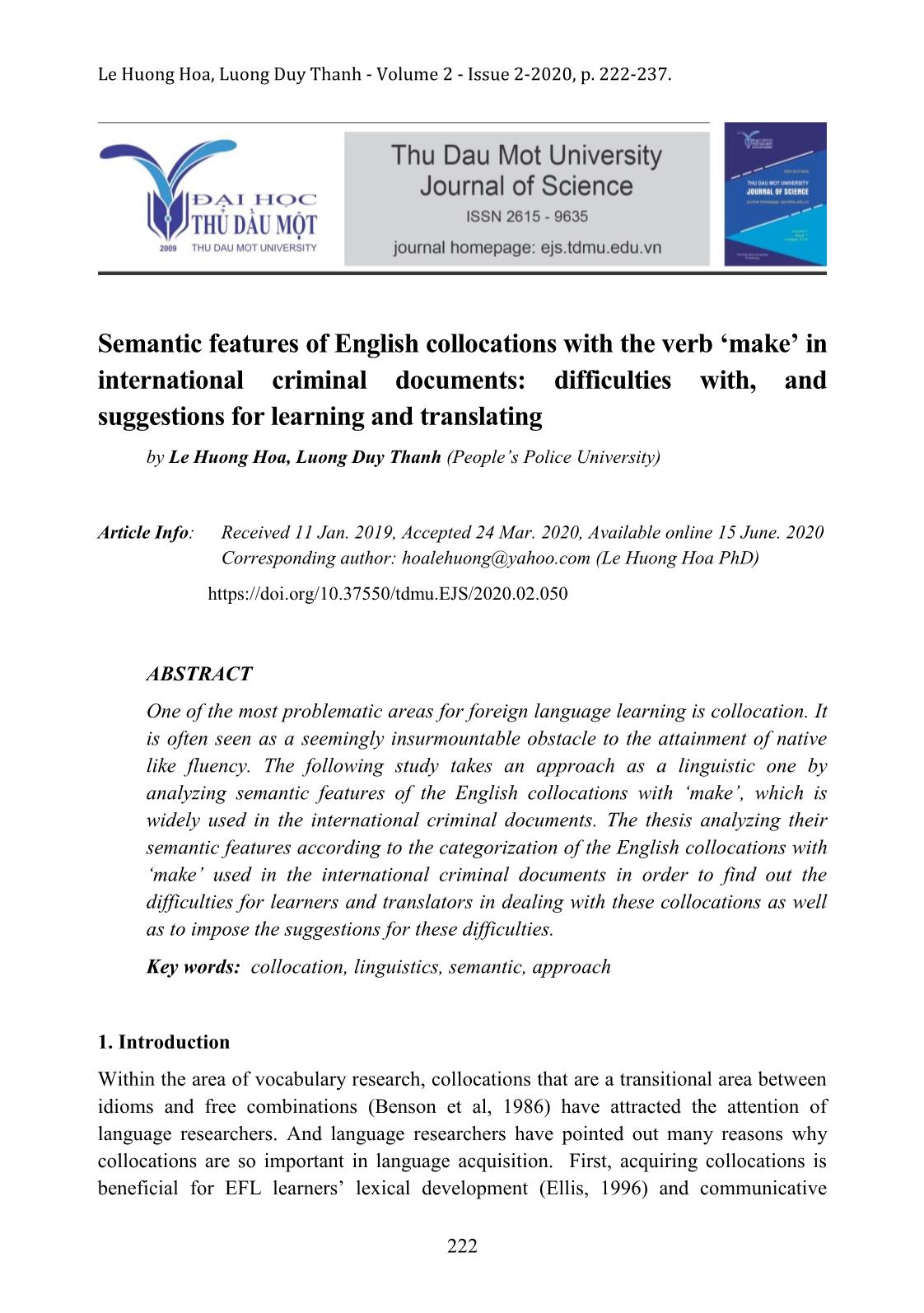
Trang 1
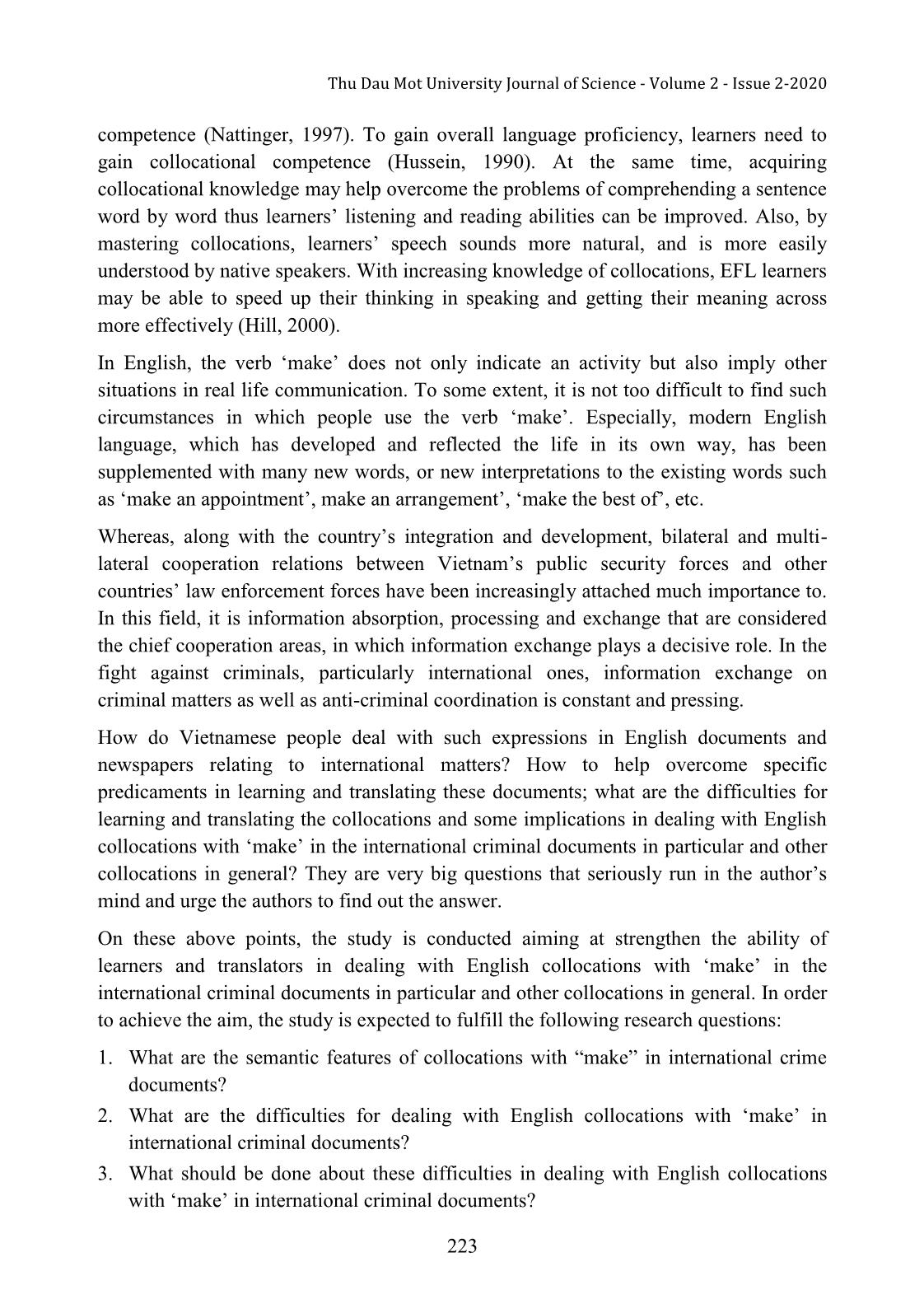
Trang 2
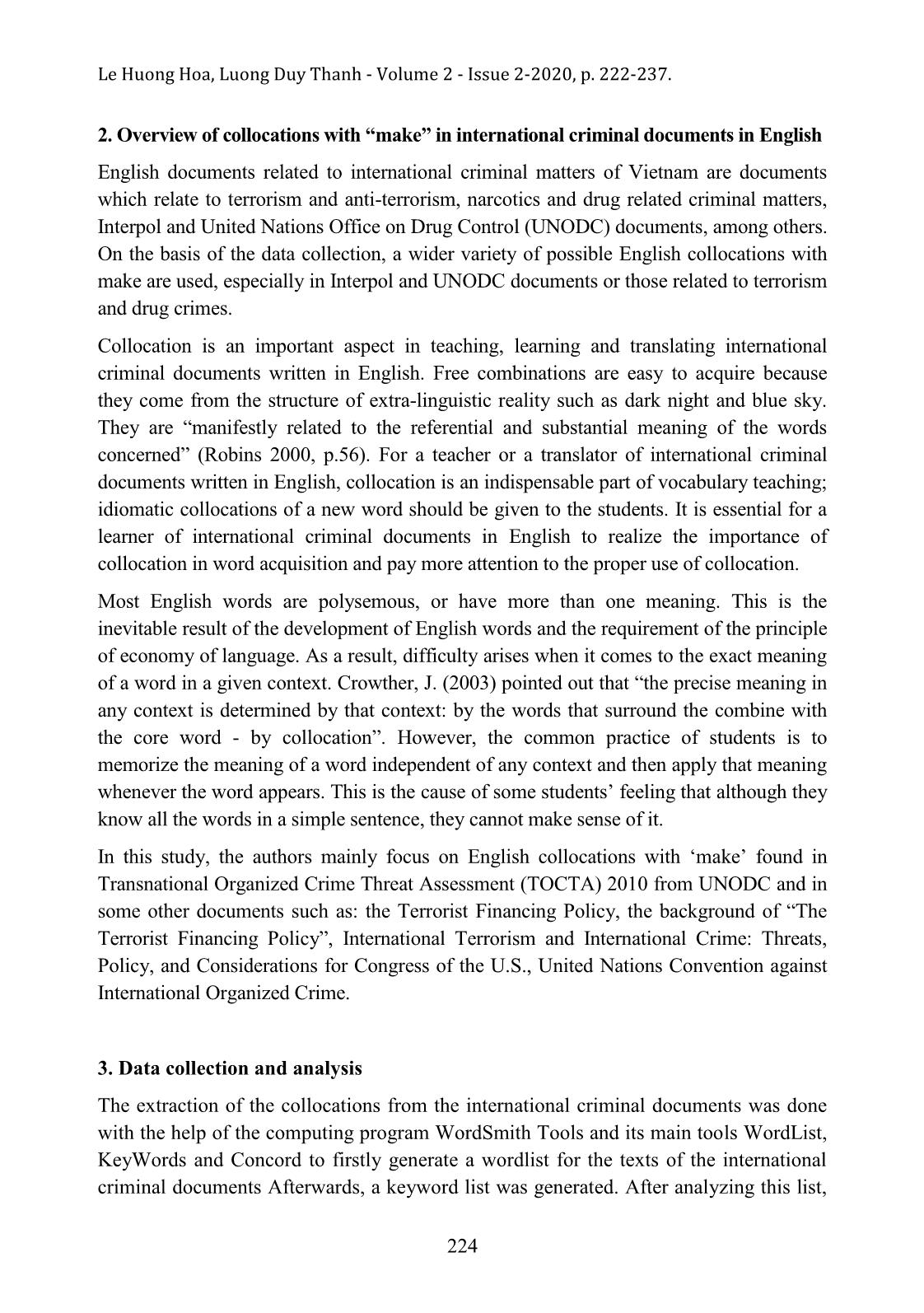
Trang 3
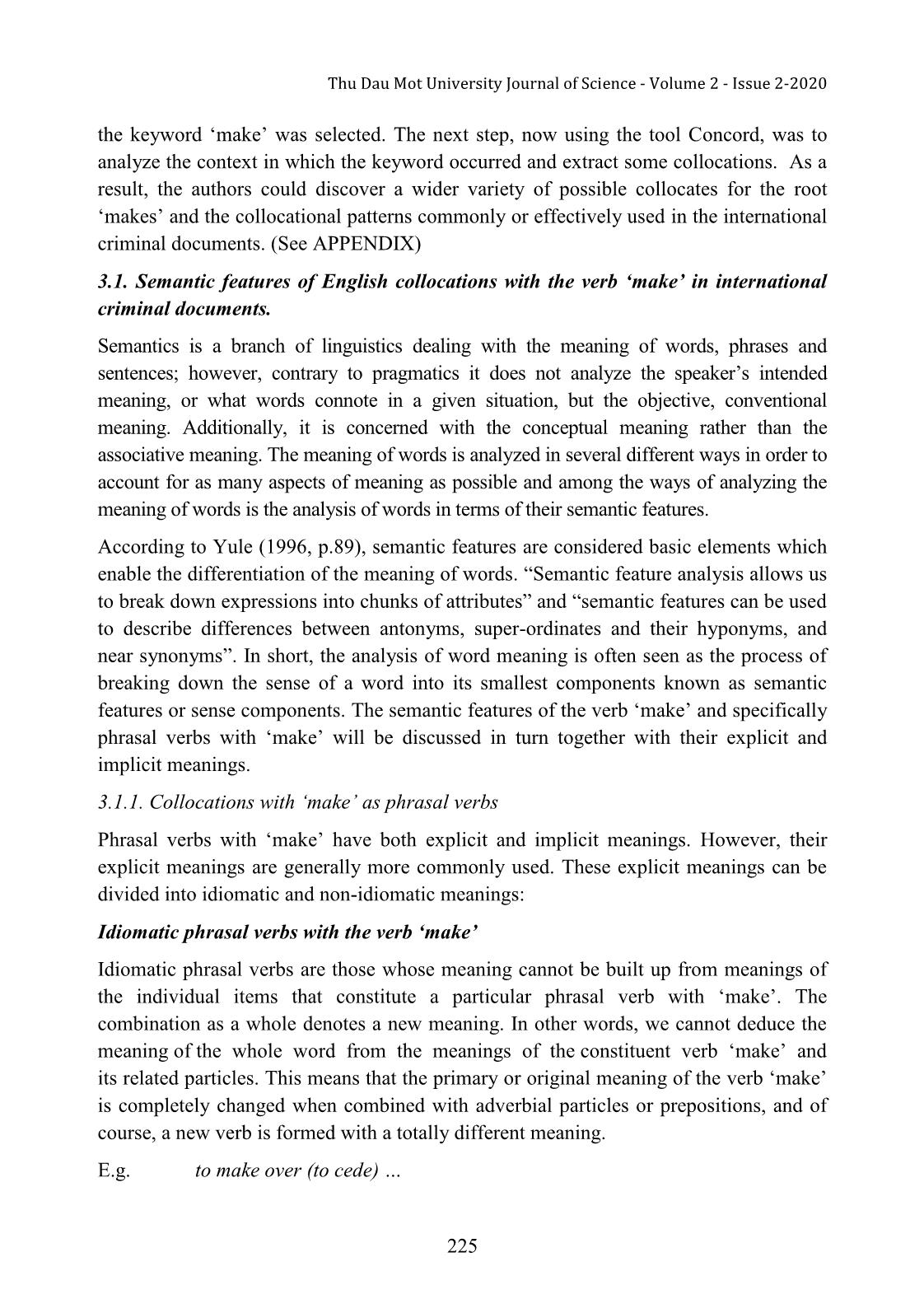
Trang 4
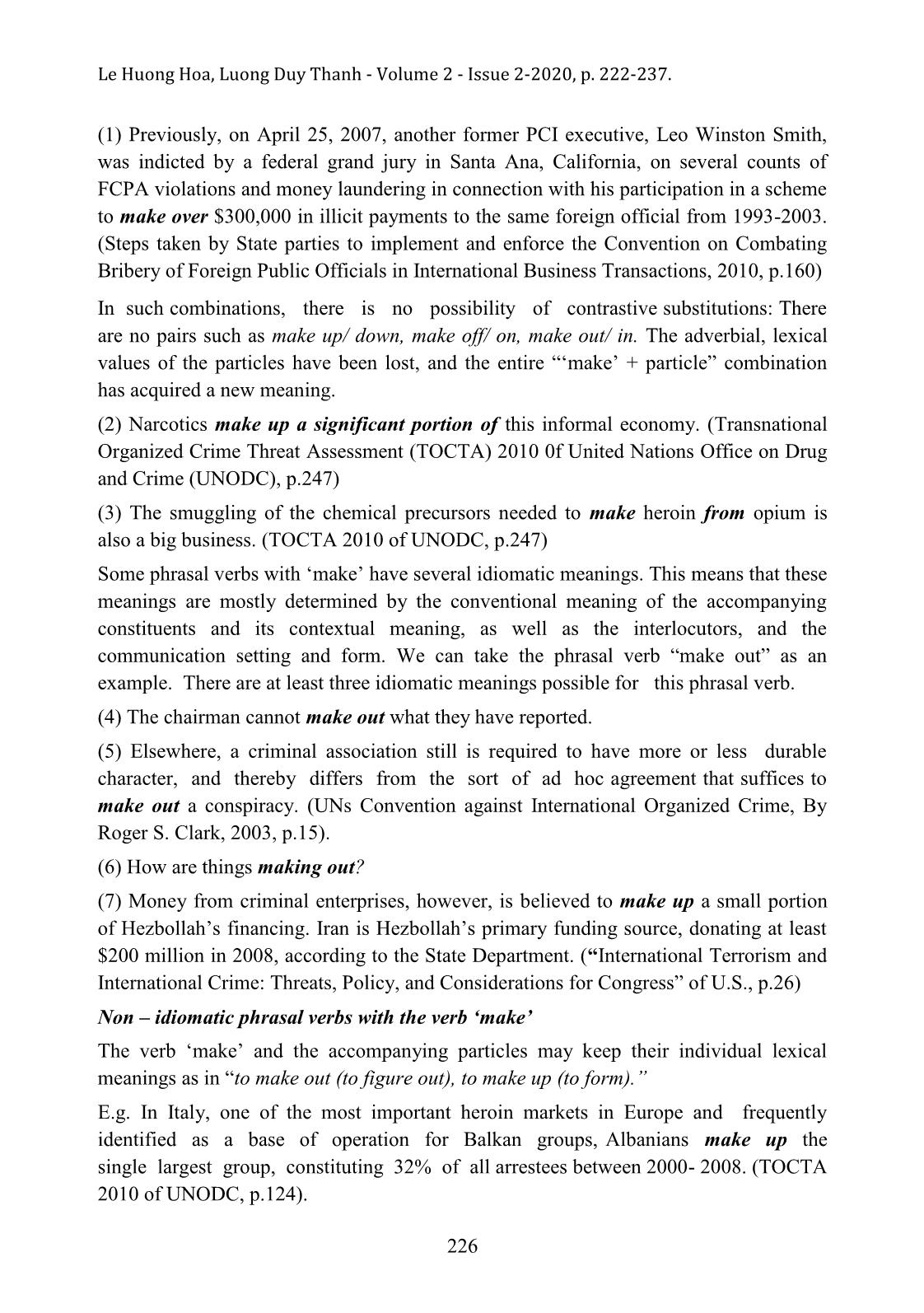
Trang 5
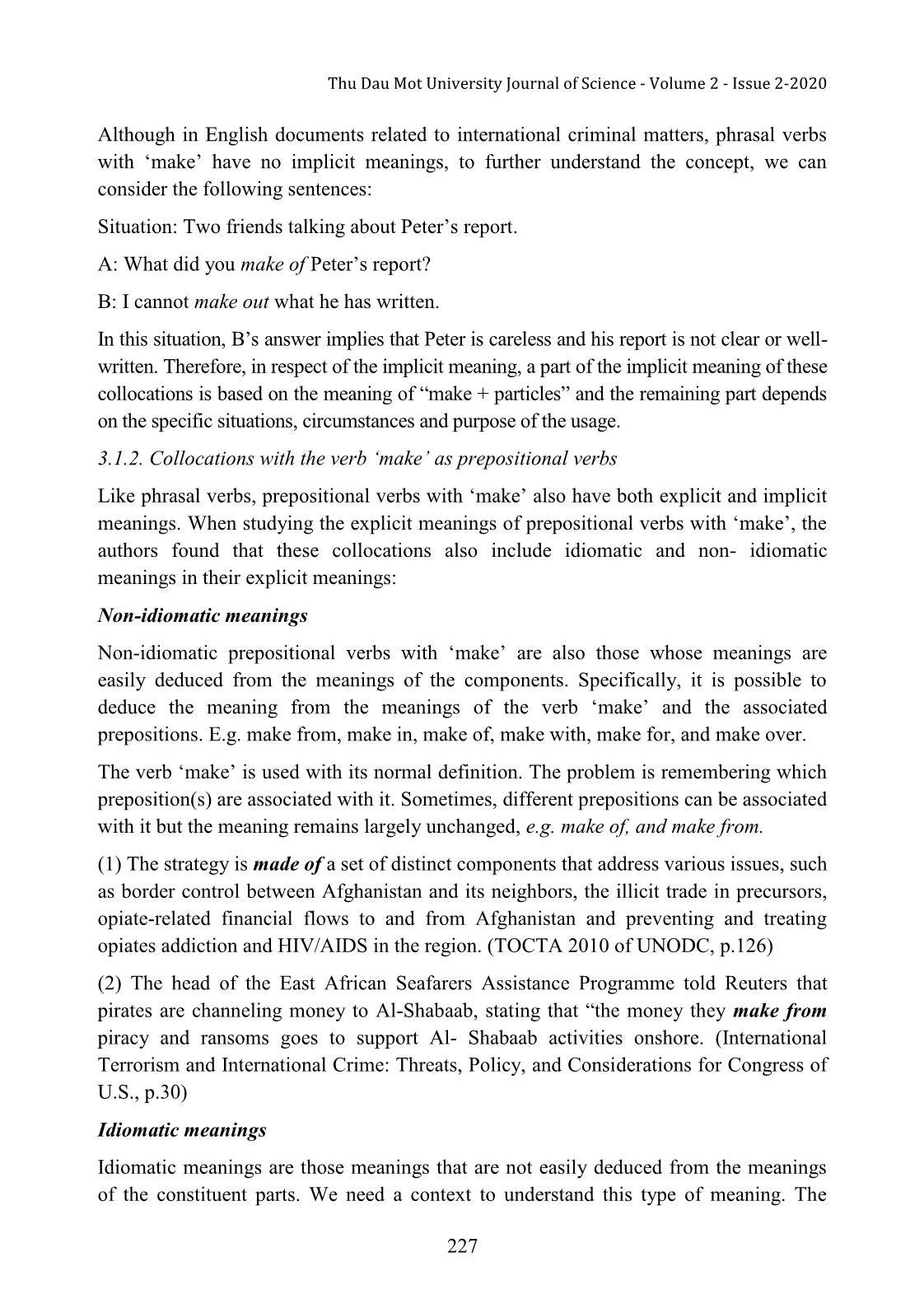
Trang 6
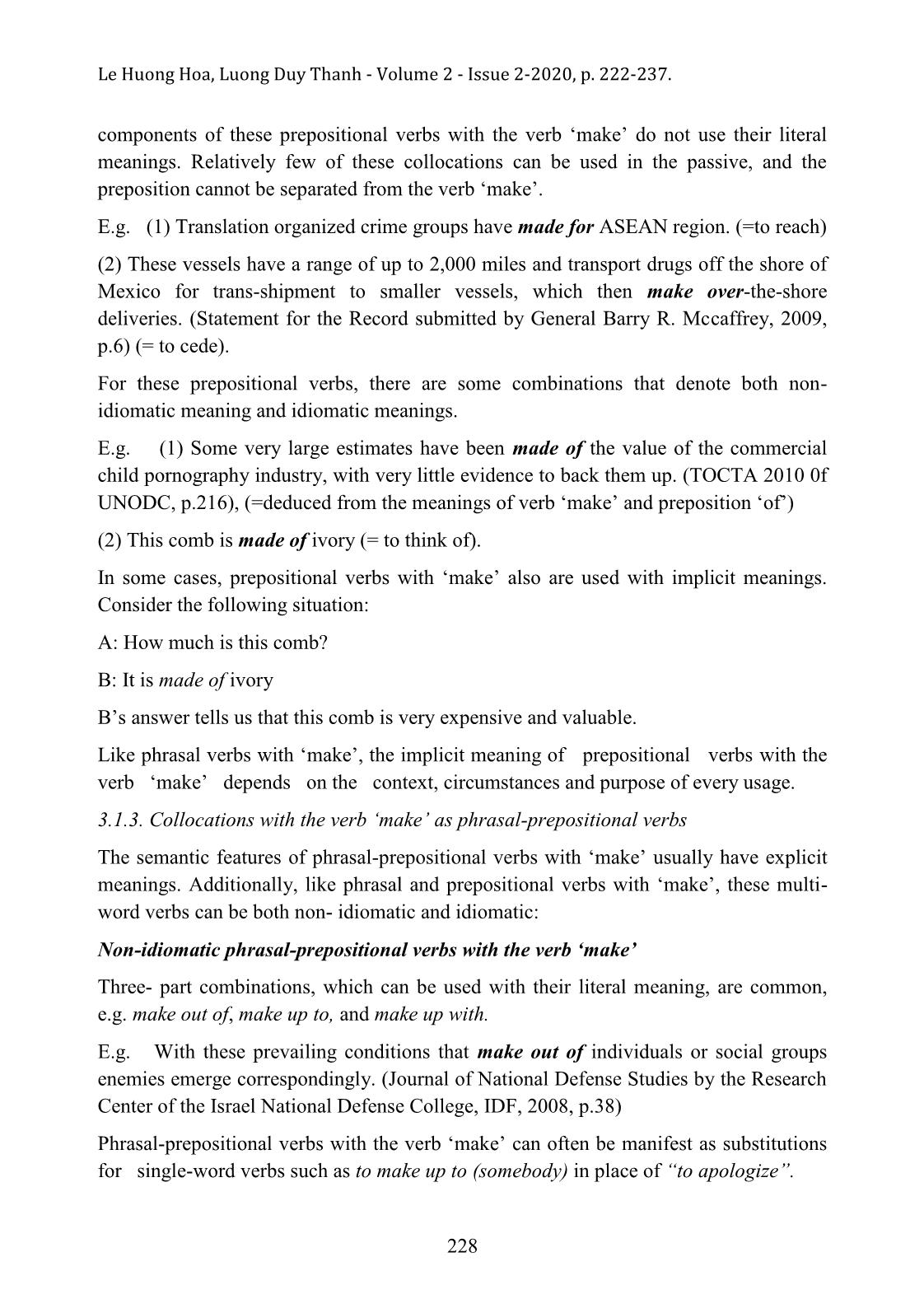
Trang 7

Trang 8
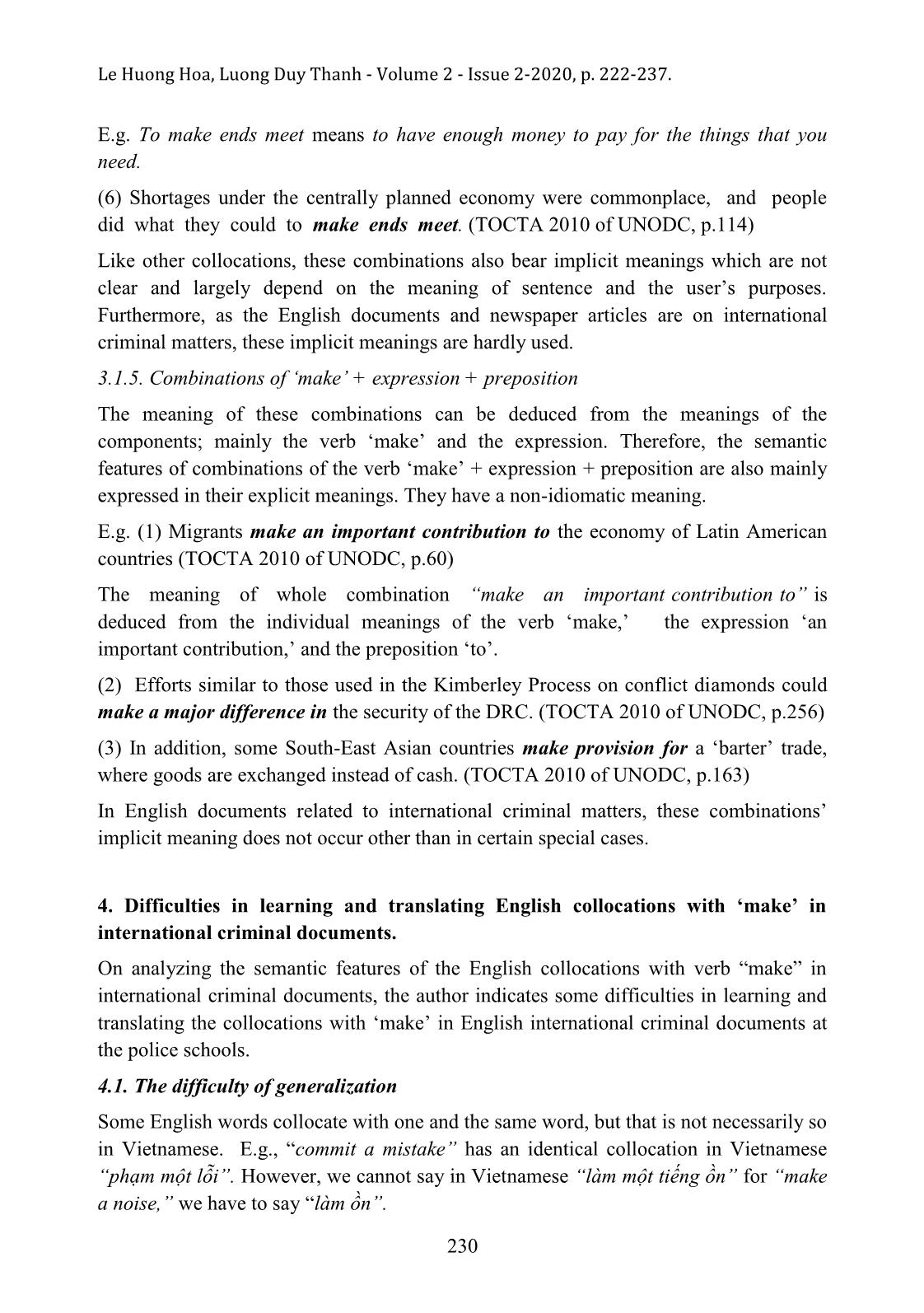
Trang 9
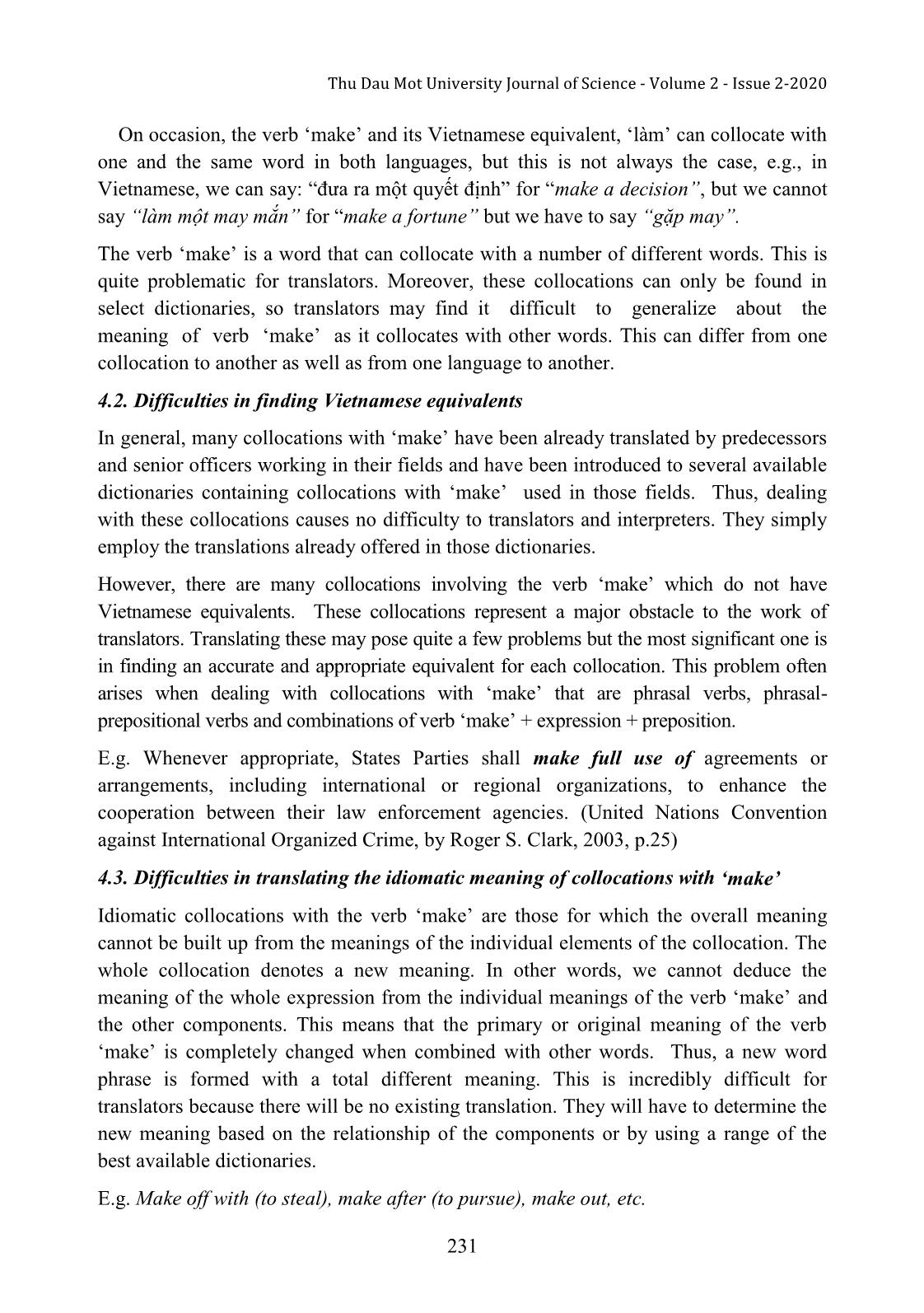
Trang 10
Tải về để xem bản đầy đủ
Tóm tắt nội dung tài liệu: Semantic features of English collocations with the verb ''make'' in international criminal documents: Difficulties with, and suggestions for learning and translating
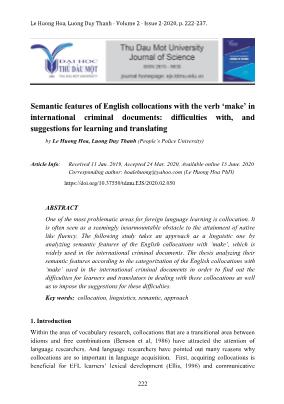
aw enforcement agencies. (United Nations Convention against International Organized Crime, by Roger S. Clark, 2003, p.25) 4.3. Difficulties in translating the idiomatic meaning of collocations with ‘make’ Idiomatic collocations with the verb „make‟ are those for which the overall meaning cannot be built up from the meanings of the individual elements of the collocation. The whole collocation denotes a new meaning. In other words, we cannot deduce the meaning of the whole expression from the individual meanings of the verb „make‟ and the other components. This means that the primary or original meaning of the verb „make‟ is completely changed when combined with other words. Thus, a new word phrase is formed with a total different meaning. This is incredibly difficult for translators because there will be no existing translation. They will have to determine the new meaning based on the relationship of the components or by using a range of the best available dictionaries. E.g. Make off with (to steal), make after (to pursue), make out, etc. Le Huong Hoa, Luong Duy Thanh - Volume 2 - Issue 2-2020, p. 222-237. 232 In addition, some collocations may have several idiomatic meanings. This means that these meaning are mostly determined by the conventional meaning of the accompanying constituents of the sentence and the contextual meaning. This causes even more difficulties for translators in that they then have to both find new meanings and then choose the most appropriate meaning. E.g. (1) The chairman could not make out what he said. (= to understand); (2) Elsewhere, a criminal association still is required to have more or less durable character, and thereby differs from the sort of ad hoc agreement that suffices to make out a conspiracy. (UNs Convention against International Organized Crime, by Roger S. Clark, 2003, p.15) (= to plan) In addition, during the translation of English collocations using the verb „make‟ commonly used in English language international criminal documents into Vietnamese, a translator may face other difficulties due to the linguistic features of English collocations and the differences between the two languages as well as the two cultures. Moreover, a translator is always under pressure to provide timely and precise information in the shortest time possible because their task concerns international criminal investigations and national security. All these requirements pose huge difficulties for a translator during the translation process. 5. Some stages and techniques learning and translating English collocations with „make‟ in English international criminal documents into Vietnamese and vice versa The English-Vietnamese translation of these collocations requires translators to use all the stages and techniques to convey the meaning of the source language into Vietnamese. That includes the use of words which already have an equivalent in Vietnamese and creating translations of new words for which no equivalent is currently available in Vietnamese. Based on the motivated (non- idiomatic) and non-motivated (idiomatic) meaning of collocations, the authors suggest four stages and some techniques to efficiently translate English collocations with verb „make‟ which often occur in English documents relating to international criminal matters into Vietnamese: 5.1. Stages Stage 1: Identify the type of these collocations As laid out in chapter 2, every type of collocation has a different pattern and set of possible meanings, so the translator has to determine the collocation type by identifying its components. E.g. Courts make institutional decisions by defining the character of rights. They can create strong rights, moderate rights or no rights at all. The character of the right represents a different institutional choice. (Convicting the Innocent in International Thu Dau Mot University Journal of Science - Volume 2 - Issue 2-2020 233 Criminal Cases: A Comparative Institutional Analysis Approach to the Problem, by Song Richardson, 2008, p.71) “Make institutional decisions” is a collocation using the pattern “Make + Noun” and has two components: the verb „make‟, and the noun „institutional decisions‟. Stage 2: Identify syntactically/ semantically meaningful units of the English collocations. In this stage, the translator will identify the general meanings of the verb „make‟, along with the meanings of accompanying components in these collocations such as nouns, verbs, objects, or adjectives. E.g. With the collocation „make institutional decisions”, we will identify: common meanings of the verb „make‟ (to create, to produce, or to cause) and the noun “institutional decisions” (institutional choices or judgments that you make after thinking and talking about what is the bed thing to do). Stage 3: Decide whether the units represent constituents or flexible word pairs. During this stage, the translator will choose the most appropriate meanings of the verb „make‟ and that of the other constituents. These meanings need to be flexible. E.g. With “make institutional decisions”, we will choose the most appropriate meanings of verb „make‟ (to cause) and noun “(institutional choices or judgments that you make after thinking and talking about what is the best thing to do). Stage 4: Find matches in Vietnamese and rank them, assuming that the highest-ranked match for English collocations is their translation in Vietnamese. In this stage, we will translate meanings of the verb „make‟ and other components chosen in stage 3 into Vietnamese by finding their equivalents in Vietnamese. Finally, the translator will rank these Vietnamese meanings to determine the highest-ranked match for the given English collocation. E.g. With “make institutional decisions”, we will find equivalents in Vietnamese of the verb „make‟ (đưa ra, tạo ra), and the noun „institutional decisions‟ (những quyết định thể chế), and then arrange them as follows “Đưa ra những quyết định thể chế”. However, these stages are most suited to „make‟ collocations that are combinations of „Make‟ + N/ O + V/ Adj, „Make‟ + Exp + Prep, or prepositional verbs. To efficiently translate „make‟ collocations forming phrasal verbs and phrasal-prepositional verbs, along with the above- mentioned stages, translators should use good collocation dictionaries described earlier because the meanings of these collocations cannot be deduced from the individual meanings of their components. Le Huong Hoa, Luong Duy Thanh - Volume 2 - Issue 2-2020, p. 222-237. 234 5.2. Techniques In employing the four above-mentioned translation stages, some techniques need to be used to produce natural translations of these „make‟ collocations and meet other requirements. 1. The technique of addition enables translators to add some words which are not found in the English language when translating these collocations, so as to make the translation increasingly fluent and coherent. E.g. “Migrants make an important contribution to the economy of Latin American countries”. (TOCTA 2010 of UNODC, p.60): “Dân nhập cư mang lại đóng góp quan trọng cho nền kinh tế các nước Mỹ La Tinh.” Obviously to convey the appropriate and fluent meaning, “mang lại” was added in the Vietnamese version whereas there is no equivalent expression to “mang lại” in the English language. 2. The exact opposite of the technique of addition, is omission which refers to the reduction of pleonastic words that might be unnecessary in conveying the meaning in the translation. In other words, translators can make use of omission to leave out redundant words that do not really change the meaning of the version. E.g. when translating “make decisions” as “quyết định”. “Make” was omitted to make the Vietnamese version more concise while retaining the original meaning. 3. Replacement requires translators of „make‟ collocations to have insights into the most common types of linguistic units: parts of speech that have a considerable influence on grammatical transformations between English and Vietnamese. The replacement of parts of speech is quite common in translation. For instance, verbs in English can be replaced by nouns in Vietnamese and vice versa to facilitate the accuracy and appropriateness of the English and Vietnamese semantics. E.g. “The fluid nature of TOC networks, which includes the use of criminal facilitators, makes targeting TOC increasingly difficult.”(Strategy to Combat International Organized Crime of U.S., 2011, p.17): “Việc tiếp cận TOC ngày càng khó khăn hơn chính là do bản chất dễ thay đổi của những mạng lưới này” Obviously, the „make‟ collocation “makes targeting TOC increasingly difficult” was replaced with the noun “việc tiếp cận ngày càng khó khăn” to provide the equivalent meaning in the target- language‟s style. 4. Expression These collocations have various forms, with some having idiomatic meanings, by virtue of their being short well-known statements or wise sayings that offer people practical advice about life. It should be borne in mind that translators, when translating collocations, ought to find in the Vietnamese language utterances or word combinations Thu Dau Mot University Journal of Science - Volume 2 - Issue 2-2020 235 which have an equivalent meaning to those in the English language. Especially since the meaning of a fixed combination is not equal to the sum of the meaning of separate words. E.g. “Money makes many things”: Có tiền mua tiên cũng được.” It should not be translated word by word in this case (e.g. Money makes many things: Tiền tạo ra nhiều thứ.”) “Instead, to be easily understandable, the translators turned to the saying with the equivalent-meaning “Có tiền mua tiên cũng được” in the Vietnamese language to transmit a clearer message to Vietnamese speakers. “Practice makes perfect”: Có công mài sắt có ngày nên kim.” Like the example above, this too is a situation requiring the expression technique. This makes the inherent meaning clear and coherent. How can the translator convey the full message if they stick to a word- for-word translation (e.g. “Practice makes perfect: Thực hành tạo nên sự hoàn hảo)? This would hardly convey any real meaning to a Vietnamese speaker due to the lack of familiarity with the custom. In English language documents and newspapers related to international criminal matters, this technique is rarely used, because the „make‟ collocations found in these documents have few idiomatic meanings. 6. Conclusion English collocations in common and English collocations with „make‟ in international criminal documents in particular can be divided into grammatical and lexical collocations. Each type of collocation may cause difficulty or confusion in learners and translators of English. This is due to the fact that there are no comprehensive clear-cut guidelines for non-native learners to decide which exact combinations are acceptable and whose co- occurrence are predictable; whose are possibly acceptable for creative purposes only, or which ones are completely unacceptable. The only way to get better grasp of these collocations is by building up an awareness of them and encountering them both receptively and productively. Based on the research results, it is hoped that would help learners and translators deeply understand semantic features of the English collocations with „make‟ in the international criminal documents in their process of language acquisition. References Benson, M., Benson, E.,& Ilson, R. (1986). Lexicographical description of English. Philadelphia: J. Benjamins Pub. Co. Crowther, J. (2003). Oxford Collocation into a reading and writing course. In M. Lewis (Ed.). Teaching collocation (70-87). London: Language Teaching Publication. Le Huong Hoa, Luong Duy Thanh - Volume 2 - Issue 2-2020, p. 222-237. 236 Ellis, N.C. (1996). Sequencing in SLA: Phonological Memory, Chunking, and Points of Order. Studies in Second Language Acquisition. Gastrow (2011). Strategy to Combat International Organized Crime of U.S. New York: Congressional Research Service Publisher. Hill, J. (2000). Revising priorities: From grammatical failure to collocational success. In Michael Lewis (Ed.), Teaching collocation: Further developments in the lexical approach. Hove, England: Language Teaching Publications. Hussein, R. F. (1990). Collocations: The missing link in vocabulary acquisition amongst EFL learners. Papers and Studies in Contrastive Linguistics. John. R (2010). International Terrorism and International Crime: Threats, Policy, and Considerations for Congress. New York: Congressional Research Service Publisher. Nattinger, J R., & DeCarrico, J. S. (1997). Lexical phrases and language teaching (2nd ed.). Oxford: Oxford University Press. Organization for Economic Co-operation and Development (2011). Convention on Combating Bribery of Foreign Public Officials in International Business Transactions. Paris: OECD Publishing. Richardson S. (2008) Convicting the Innocent in International Criminal Cases: A Comparative Institutional Analysis Approach to the Problem. New York: UN. Publishing. Robins, R.H. (2000). General Linguistics (Ed.4). Beijing: Foreign Teaching and Research Press Roger. T. B. (1991). Translation and translating: Theory and practice. London: Longman Roger S. (2003). UNs Convention against International Organized Crime. New York: United Nations Publishing. UNODC. (2010). Transnational Organized Crime and Threat Assessment. Vienna: United Nations Publication. Yule, G. (1996). The study of language. Cambridge: Cambridge University Press. Appendix Hereafter are the collocations with the verb „make‟ extracted from international criminal documents in English (mainly TOCTA 2010 of UNODC): - Make function as - Make extradition - Make threat to - Make available - Make ends meet - Make progress - Make provision for - Make difference in - Make it + Adj. - Make policy - Make a decision - Make a claim - Make a complaint - Make a concession - Make contact (with) - Make demands on - Make an effort - Make up - Make against - Make out - Make from something - Make in something Thu Dau Mot University Journal of Science - Volume 2 - Issue 2-2020 237 - Make contribution to - Make an enquiry - Make a break - Make arrangements - Make an argument for - Make an attempt - Make the best of - Make a bow - Make a cancellation - Make a charge - Make of something - Make up for something - Make up to somebody - Make full of something - Make room (place) for somebody - Make terms with - Make after - Make off with - Make up for - Make out of
File đính kèm:
 semantic_features_of_english_collocations_with_the_verb_make.pdf
semantic_features_of_english_collocations_with_the_verb_make.pdf

